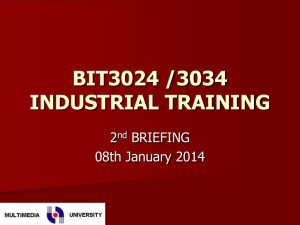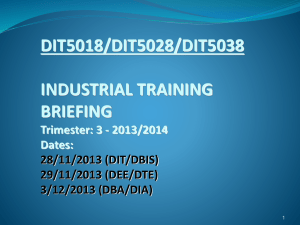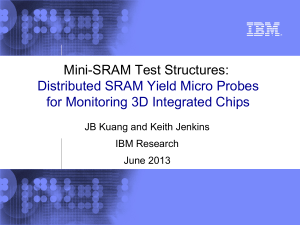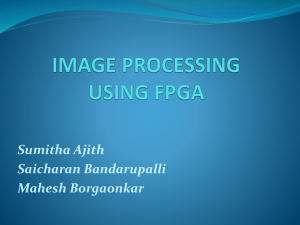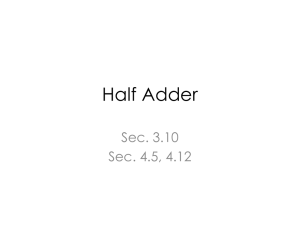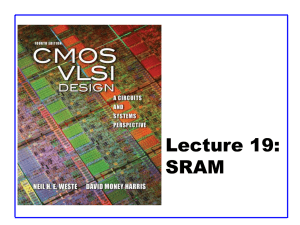Media:VLSISOCFinalAB
advertisement
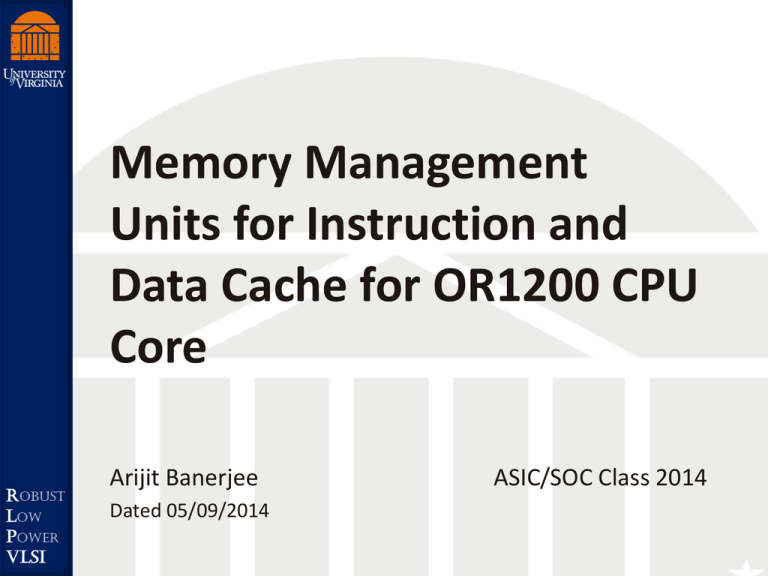
Memory Management Units for Instruction and Data Cache for OR1200 CPU Core Robust Low Power VLSI Arijit Banerjee Dated 05/09/2014 ASIC/SOC Class 2014 Motivation ASICs/SoCs have billions of transistors Impossible to design everything manually Cad tools to the rescue To learn the basic full cad flow for ASIC/SoC design MMU hard IP design as part of full processor design project 2 Overview of Memory Management Unit Memory Management Unit (MMU) an essential module in modern processors Manages translation of virtual (logical) memory address space to physical address space Provides memory protection for software programs Source : http://en.wikipedia.org/wiki/File:MMU_principle_updated.png 3 Introduction to OR1200 and Its MMUs Two MMUs defined Instruction MMU Controls I cache Data MMU Controls D cache Interfacing with wishbone bus interface Source: OR1200 Specification 4 MMU Address translation Mechanism in OR1200 MMUs MMU divides the virtual address space into pages It uses an in-memory table of items called “page table” that contains a “page table entry” (PTE) per page, to map the virtual page numbers to physical memory PTE has an associative cache called translation lookaside buffer (TLB) to avoid accessing main memory per address translation Source: OR1200 Specification 5 Basic Cad Flow for MMU Hard IP Design Verilog Source Modification Source HDL Modification Synthesis of individual blocks Formal Verification Place and Route Functional Simulation Synthesis Formal Verification Physical Design Physical Library for top level integration 6 Simulation Tool used Synopsys VCS Issues Functionality of the MMU was not documented explicitly Hard to interpret functionality using the lengthy modular Verilog code Simulated using random inputs 7 Design Synthesis Tool Used Design Compiler Synthesized IMMU and DMMU separately Clock and Reset pins had slow timing constraints of 50ns Default Input/output pin-load constraints Actual SRAM memory Verilog was integrated as black box for synthesis 8 Synthesis Result Snaps IMMU Synthesis snapshot 9 Formal Verification Tool used Formality SRAMs were treated as black boxes in the verification SRAM Verilog was ports only for comparison Successfully verified both IMMU and DMMU 10 Milkyway Database Preparation for SRAM Hard Macros Created the Tutorial for SRAM hard macro data base preparation Method Create the library and attach the technology file Import the DEF there after Issues Directly DEF imports fails due as the DEF does not have technology file information Verilog and DEF has port mismatch due to SRAM compiler bug for Verilog generation 11 Place and Route Tools use IC Compiler (ICC) Used the SRAM hard macro Milkyway databases 64X14, 64X22 and 64x24 macros IMMU need manual floor planning as SRAM macros were overlapping on top of each other Placement of Hard macros were fixed Placement blockage was placed over the SRAM macros DMMU uses normal scripted flow 12 ICC Result Snapshots Before fixing the aspect ratio DMMU and IMMU 246 X246 square microns 13 ICC Result Snapshots After fixing the aspect ratio at 1.318 for DMMU and IMMU 289X220 square microns 14 Deliverables Wiki updated with all the deliverable materials including the Milkyway database creation with SRAM DEFs tutorial Scripts uploaded in wiki DVE DC Formality ICC SRAM Milkyway databases for macros 64x14, 64x22 and 64x24 uploaded in wiki and collab Full placed and routed macro uploaded in collab dropbox 15 Issues Faced Had less time to learn the full flow Skipped the Hercules DRC and LVS for the design Also skipped Primetime signoff Place and route using ICC showed following issues those are yet to be resolved Floating net issues flags errors VDD and VSS disconnection errors In some cases, for unknown causes the ICC takes infinitely long time to check “Notch DRCs” 16 Conclusion We learned a great deal of information about the full cad flow for ASIC/SoC design Also learned about the OR1200 and its DMMUs and in general MMU’s internal working mechanism Had hands on tools and its flows like VCS, DC, Formality, ICC etc. Delivered the final Milkyway database for the DMMU and IMMU within the course time However, had issues with ICC about net connection errors those are yet to debug 17 Future Possibility To start the project earlier after two to three weeks from starting Collect more information about the ICC flow and Develop a concrete ICC flow that works Include EMIR in the ICC flow (already made the tutorial ) Include Hercules DRC and LVS verification for the final layouts Signoff timing checks using prime time (Integrate a full project and tapeout) 18 Questions 19 Overview contd. TLB is not mandatory; however it improves address translation speed A PTE can include information about If the page is written When it was last used What process has the PTE associated with Weather or not it should be cached etc. 20



